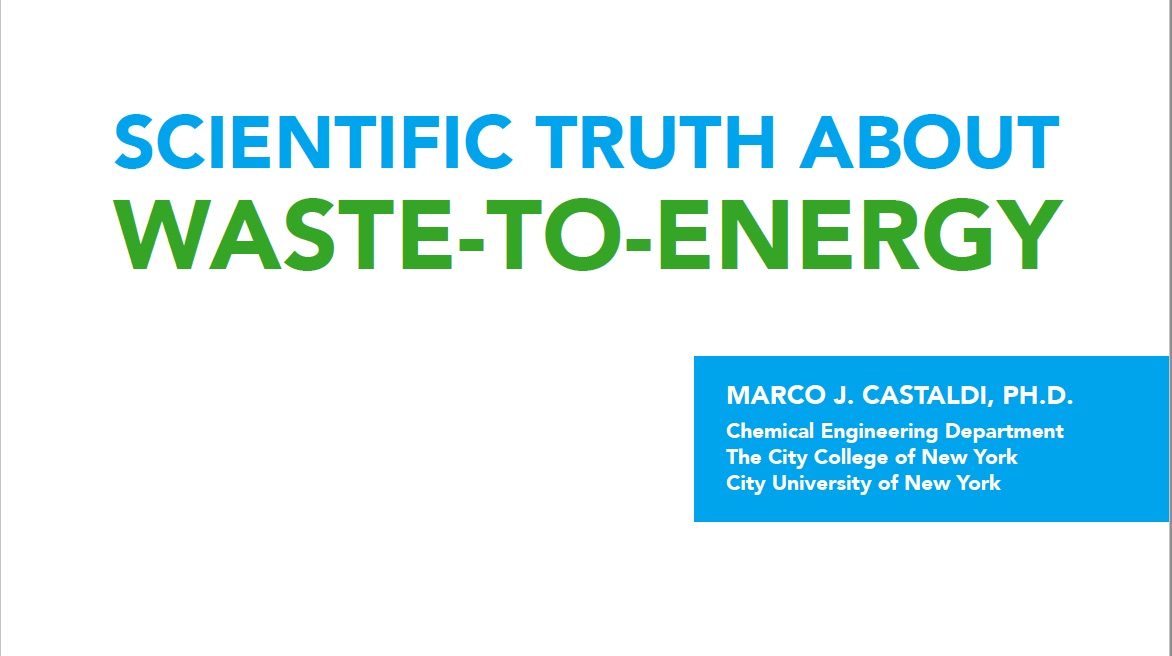SCIENTIFIC TRUTH ABOUT WASTE-TO-ENERGY
WTE REPORT – Marco Castaldi – IERM reviewed 07-24-20
MARCO J. CASTALDI, PH.D. Chemical Engineering, City College of New York, University of New York.
PREFACE: Our society’s increasing focus on the interrelationship of energy and the environment, including in particular sustainable waste management, has prompted the need for a comprehensive review of generating energy from waste. While there is growing interest in a circular economy that facilitates productive reuse of Municipal Solid Waste (MSW), there is also significant confusion and misinformation regarding sustainably managing MSW using “Thermal Conversion” or “Waste-to-Energy” (WTE) methods. Juxtaposed with that confusion and misinformation are the facts, which show that WTE plays a key role as part of an environmentally sound system that includes full protection of human health and where post-recycled MSW supplies the energy to serve residential, commercial and industrial needs. That is the context for this study, which provides the most up-to-date information on WTE and the environment, and which can serve as a comprehensive resource for policy makers and others interested in learning more about the quantifiable benefits of WTE.
This work has been reviewed by the following experts who possess first-hand knowledge and experience with WTE and are recognized internationally for their research and other scientific and engineering contributions:
- • Prof. Nickolas Themelis – Columbia University
- • Prof. Ashwani Gupta – University of Maryland
- • Prof. Frank Roethel – State University of New York, Stony Brook
- • Mr. Anthony Licata – ASME Fellow, Licata Energy & Environmental Consultants, Inc.
- • Prof. Morton A Barlaz – North Carolina State University
- • Dr. Helmut Schnurer – Former Deputy Director General, Ministry for Environment, Germany, IeRM
- • Dr. Michael Weltzin – Senior Science Advisor, Waste and Climate Policy, German Green Party, IeRM
- • Rene Moeller Rosendal – Danish Waste Solutions, ISWA Vice Chair Landfilling, IeRM
- • Richard C. Honour, PhD – Executive Director, The Precautionary Group, IeRM
- • Philipp Schmidt-Pathmann, MBA, MIS – Founder and Executive Director, IeRM
The world has more MSW now than at any point in history. The US alone generates nearly 300 million tons of MSW per year, a number that rises each year as the population grows, according to the most recent federal data. This MSW is managed in the US in three ways:
- • Recycling and Composting (34.7%)
- • Waste-to-Energy (WTE, 12.8%)
- • Treatment and Disposal (Primarily by Landfilling, 52.5%)
WTE is the better alternative to landfilling for managing MSW that is not recyclable, a reality explicitly recognized by the waste management hierarchy recommended by both the US Environmental Protection Agency and the European Union. With 76 WTE facilities in the US and 410 in Europe, WTE is a proven technology for heating, cooling, industrial processes and electric power production that displaces fossil fuels, and at the same time has a significantly lower carbon (GreenHouse Gas [GHG]) footprint compared to landfilling. WTE also has the added benefit of destroying contaminated
materials that contain pathogens, parasites and toxins. While there is great interest in increasing recycling and materials recovery, with many communities working toward laudable zero waste goals, a number of factors limit our ability to significantly increase recycling, including:
- • Demand for recyclable products has declined
- • Requirements for processing recyclable materials have increased
- • Requirements for producing salable products from recyclables have increased
As a consequence, landfill volumes and the methane they generate continue to increase. This report describes the key role WTE can serve in the US to provide a sustainable waste management future that is fully protective of human health and the environment.
SUMMARY: From this report, readers will build a better understanding of the scientific realities of WTE, as it relates to waste management, recycling, public health and the environment:
• Landfills are the primary alternative to WTE, yet methane emitted by landfills is the second largest contributor to global climate change.
• Every ton of waste processed in a WTE facility avoids a ton of CO2 equivalent in emissions, most especially when GHG savings from recycled recovered metals are included.
• US counties and municipalities that use WTE consistently show increased recycling rates.
• Human health is not adversely affected by WTE.
• WTE facilities in the US and globally operate well within environmental standards.
• The global trend is toward the growth of WTE facilities to manage increasing amounts of waste, while extracting energy and valuable materials for recycling.
• Evaluating WTE in isolation is misleading because it ignores the adverse environmental and energy impacts of landfilling at great distances from the sources of waste.
• Reduce, Reuse and Recycle are generally recognized by the public, but there remain significant misunderstandings of the energy recovery process.
• There are 76 WTE facilities in the US that process nearly 94,000 tons of MSW per day, producing enough energy to power the equivalent of 2.3 million homes.
• WTE is a $10 Billion industry, employing 6,000 workers in the US, and growing worldwide.
CONCLUSION: WTE is a critical component of the accepted MSW hierarchy, and can be a significant tool for avoiding landfilling of residual waste after reduction, reuse and recycling. This report summarizes how WTE is a key part of a sustainable MSW management solution and a responsible alternative, when environmental and human health impacts are considered.
Link to Full Article: https://ccnyeec.org/wp-content/uploads/2021/05/WTE-REPORT7603.pdf





